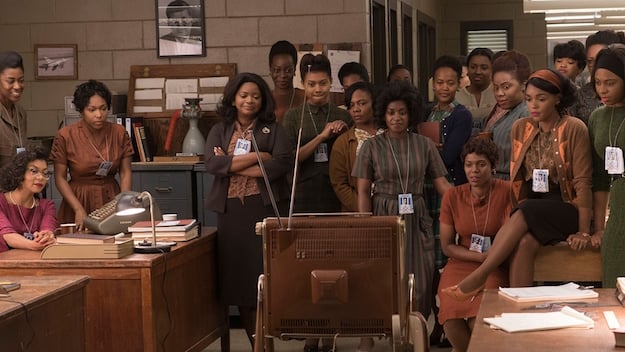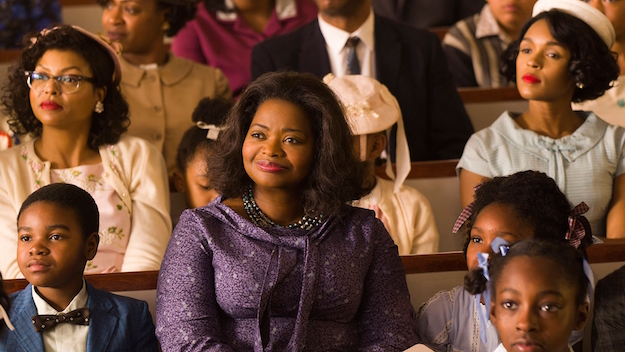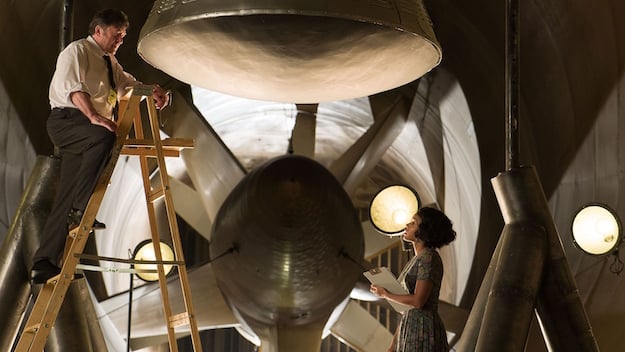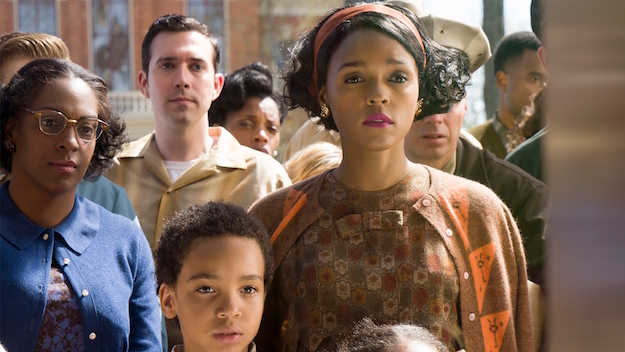Deep Focus: Hidden Figures

Launching a bright, rousing entertainment about a real-world subject onto thousands of movie screens is a major feat. The creators of Hidden Figures, a fictionalized history of the black female math wizards who helped get NASA off the ground in the 1960s, make it look as easy as one, two, three. The director, Theodore Melfi (St. Vincent), imbues his complicated narrative with a three-part clarity that allows his cast—not just his gifted leads, Taraji P. Henson, Octavia Spencer, and Janelle Monae, but also ace actors Kevin Costner and Mahershala Ali—to glide engagingly and intelligently from drama to comedy, from irony to uplift. Melfi’s showmanship puts a gloss on the material while retaining its freshness. The movie sets off revelatory tingles as it chronicles NASA’s exploitation of its female calculators—known as “computers”—and then its adoption of electronic computing with a massive IBM mainframe.
First, Melfi smartly collapses much of the history of these stellar number crunchers into 1961 and ’62. Americans, not used to playing catch-up, worry about the Soviets conquering space with Sputnik satellites and cosmonaut Yuri Gagarin, but are also thrilled at the prospect of putting U.S. citizens into orbit—thanks partly to the soaring rhetoric of President John F. Kennedy, who proclaims, in a newsreel clip, “We choose to go to the moon in this decade and do the other things, not because they are easy, but because they are hard.” The concentrated chronology allows Melfi to bring home the message that an appeal to national ideals in one area, like the space race, can open up new frontiers in others, like civil rights. (Right before he delivered the quoted line, JFK said, pointedly, “There is no strife, no prejudice, no national conflict in outer space as yet.”) The contest for the cosmos also supplies the film with some ticking-bomb suspense. The archival footage reminds us that astronauts ride into space on the force of quaking, timed explosions.
Second, Melfi never loses sight of his heroines’ dual struggle, as women and as black people. He encourages his actors to play on that duality with wisdom, anger, and a nuanced sort of farce. At the start of the story proper, Henson’s Katherine Goble (later to become Katherine Johnson), a grownup prodigy now working as a “computer,” Mary Jackson (Monae), a computer with the brain and drive of an engineer, and Dorothy Vaughan (Spencer), their unofficial supervisor, are having car trouble when they see a Virginia state policeman heading their way. “No crime in a broken-down car,” says the sage and steady Vaughan. “No crime in being Negro neither,” says tough, outspoken Mary. When the cop asks for identification, he learns they’re en route to NASA’s Langley Research Center in Hampton, where, Vaughan adds, they do “a great deal of the calculating getting our rockets into space.” When the cop begins “I had no idea they hired—”, Vaughan quietly cuts in: “There are quite a few women working in the space program.” The women end up racing to work with a police escort. This scene sets the movie’s comic-dramatic rhythm on track, and Melfi never jumps the rails. He keeps alternating risk and humor, tension and release, with a jolly and exciting forward motion. Even the repeated sight of Katherine racing from the Space Task Group on the white East Side of NASA’s campus to the “colored” rest room on the West Side, half a mile away, adds to the film’s seriocomic momentum. These 880-yard dashes in high heels as she carries stacks of documents testify to her solid middle-class grit.

Third, Melfi turns these three women into a group hero representing a bigger group—the dozens of black female computers, as well as the far greater groups of under-respected brilliant women and disrespected African-Americans, without slighting their individuality.
This director is no flashy stylist, but he has a true showman’s instinct for setting each character in our mind visually as well as dramatically. Katherine, the first African American woman to attend graduate school at West Virginia University, is a wunderkind who must learn how to work wonders as an adult. She becomes a catalyst for NASA elevating its black female employees. Even as a little girl Melfi shows her on the move, practicing prime numbers as she ambles through the woods, then teasing geometric shapes from the designs in a stained-glass window. Three decades later the Space Task Group will need her expertise in analytic geometry. Now a widowed mother with three daughters, she enters her new job humbly, anxious to prove her worth. She endures obstructionism and an almost sadistic condescension from the lead engineer (Jim Parsons) as well as the casual racism and isolation of being the sole black and second woman in the room. She looks throttled behind her desk, then frantic as she sprints to the restroom. Forced to check the math in reports redacted beyond recognition, she discovers a work-around that allows her to predict a rocket failure. Melfi and Henson depict her stepping up a ladder in a state of hyper-concentration to chalk out equations on a mammoth blackboard. Her work gains her a no-nonsense ally in the Task Group chief, a composite character named Al Harrison (Kevin Costner), who values her dedication and ingenuity as well as her analytic wizardry. Melfi’s production team places Harrison up a flight of stairs in a glass office, with a panoramic view of his department. Costner plays against this grandeur with a first-rate portrait of a pragmatist as hero, intense and brusque, boasting plainspoken eloquence and deadpan sensitivity and wit.
Costner and Henson’s cerebral pas de deux generates the film’s subtlest passages. Bespectacled and restrained, Henson leaves vanity behind as a woman with the intellectual faith that “numbers don’t lie,” while Costner crafts an authority figure without any taint of sentimentality or paternalism. These characters recognize each other’s excellence. Their unspoken bond emboldens Katherine to nudge Harrison into opening doors for her—and once she walks through, Harrison is canny enough to push her to her limits. Together, Henson and Costner convey the magnetism of total professionalism.

With Mahershala Ali as Colonel Jim Johnson, an Army man and National Guard honcho who becomes Katherine’s second husband, Henson puts across something different, something soft yet formidable—the sensual allure of refinement and formality. Katherine’s romantic distance proves to be direct, not coy: she’s frank about taking Johnson’s measure as a man. Ali, an instantly persuasive actor (as he shows in Moonlight) as well as a superb romantic partner (as he shows in House of Cards), conjures a charismatic understatement as the suitor who’s ready to meet her challenge. In Moonlight he’s loose and individualistic as Juan, a drug dealer from Cuba, while in Hidden Figures he’s commanding and courtly yet also endearingly stiff as a career military man. In both movies Ali’s silences are as warm and charged with meaning as his characters’ hard-earned statements of wisdom and stirring declarations of feeling.
Melfi frequently views Dorothy close to the ground, enabling Spencer to draw on her own rootedness. On first sight, we see only Dorothy’s legs—the rest of her is under that broken-down car, repairing it. She’s a genuine Ms. Fix-It, even with that mysterious, recalcitrant new IBM contraption. Passed over for a managerial promotion that white men would receive as a matter of course, Dorothy doesn’t mince words about her impatience with her coolly impersonal white counterpart, Vivian Mitchell (Kirsten Dunst, lending texture to a thankless role). She’s been at NASA longer than her sisters-in-arms, and she’s tired of practicing her well-honed survival skills. But Dorothy doesn’t let her frustration get the best of her. She moves shrewdly, gracefully, and implacably through NASA’s corridors, whether surprising Mitchell at her desk or invading the IBM office and learning how to work the machine without any IBM men even noticing her. Friendships and family life fuel her resilience. (The real Vaughan had six children; here we get to know two.) Spencer’s gift for suggesting the hidden layers of underestimated women makes her the perfect actress to play a model of strength and endurance. In Hidden Figures, her combination of fortitude and sneak-attack intelligence makes her deeply funny and inspiring.
Monae has tremendous zest as Mary; with any luck, this Afro-futurist singing star will become a major movie actor. Melfi and Monae depict her as both an unmovable object and an irresistible force. Even when she’s standing still she sets off good vibrations. She gives the entire film a livewire, contemporary spark without being anachronistic or narcissistic. Fifteen years younger than her co-stars, Monae imbues Mary with a youthful attitude that sometimes drives the other computers crazy, as when she ogles the visiting astronauts and says, “It’s equal rights—I have the right to see ‘fine’ in every color.” (When the gentlemanly John Glenn saunters over to meet the black computers, Mary shakes his hand in both of hers). Monae pulls off Mary’s ebullience and her wisecracking form of resignation with élan. By the end, she also shows enormous range, voicing Mary’s belief in the necessity of smashing precedents with an unselfconscious conviction that comes from the marrow and can’t be faked. In Moonlight, Monae plays Teresa, Juan’s romantic partner, with unreserved emotionalism and informal grace. In Hidden Figures it’s hilarious, provocative, and exhilarating to see Mary’s fearless temperament—and Monae’s—confront Jim Crow laws and NASA protocols.

The three stars interact beautifully. Their confidence in their different body types and their generosity as performers make it satisfying to watch them walk together. It’s a little bit of ecstasy to see these friends dance together. Melfi and his cinematographer, Mandy Walker, deftly choreograph their movements through NASA’s hallways, counterpointing claustrophobia with awe, and the whole movie takes a breath of fresh air when they attend a Sunday service and an outdoor church lunch. When it comes to the astronauts and outer space, the moviemakers simply borrow from the best—several scenes are like more conventional remakes of episodes from The Right Stuff. Glen Powell proves to be amusingly boyish as Tom Wolfe’s “squeaky-clean Marine,” John Glenn, and Melfi builds the arc of the astronaut’s trust in Katherine’s calculations toward a gratifying payoff.
The film occasionally stumbles in its storytelling, notably when Katherine abruptly and temporarily gets demoted, and in its staging, especially when Dorothy joins a roadside group listening to a broadcast of Glenn’s risky re-entry with a wobbly heat shield. What matters most, though, is that the flight of Friendship 7 becomes a grand summing-up of the film’s major ideas, including its beliefs in positive group efforts and organic consciousness-raising. It will be an ideal film for Martin Luther King Day because it’s about being judged on the content of our character. After his lead engineer balks at having Katherine review his math, Costner’s Harrison demands, “America’s greatest engineering and scientific minds are not going to have a problem with having their work checked.” He concludes, “So let’s have an ‘amen,’ damn it.”
Amen.
Michael Sragow is a contributing editor to Film Comment and writes its Deep Focus column. He is a member of the National Society of Film Critics and the Los Angeles Film Critics Association. He also curates “The Moviegoer” at the Library of America website.







